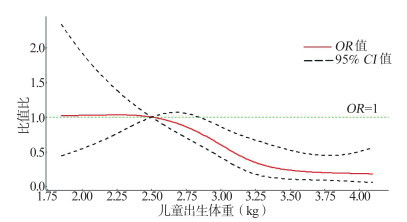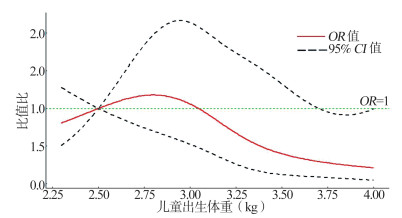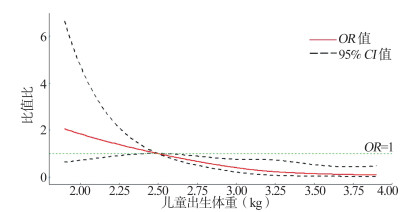Study on influencing factors of congenital heart disease in children aged 0-6 years based on case-control and dose-esponse relationship
-
摘要:
目的 分析甘肃省0~6岁儿童先天性心脏病(congenital heart disease, CHD)的非遗传影响因素,为预防儿童CHD提出建议。 方法 采用分层等距抽样方法,在甘肃全省抽取并筛查5个区县0~6岁儿童29 566例。将从中筛查出的106名CHD患儿作为病例组并随机抽取同年龄、同性别、相同生活环境下的健康儿童318名,作为对照组进行1∶3病例对照匹配;应用Cox比例风险模型拟合Logistic回归分析模型分析儿童CHD的影响因素;应用限制性立方样条模型分析儿童出生体重与CHD患病的剂量反应关系。 结果 多因素分析结果表明:儿童出生体重、母亲文化程度、食用腌晒食品、药物流产史、孕前服用排卵药物、孕期食用鱼肉、经常体育锻炼与儿童CHD的患病风险均存在相关性(均有P<0.05)。限制性立方样条反应分析结果显示:儿童出生体重与CHD患病的关联强度呈线性剂量—反应关系(总趋势P<0.001,非线性P=0.246)。 结论 建议育龄妇女做好孕前检查,合理使用促排卵药物;孕期妇女要做好孕期保健和筛查,多食用鱼虾等海产品,不食用腌晒食品,适当进行体育锻炼,加强妇幼保健知识的学习降低儿童CHD的患病风险。 Abstract:Objective By analyzing the non-genetic factors of congenital heart disease (CHD) in children aged 0 to 6 years in Gansu Province, suggestions were put forward to prevent CHD in children. Methods We chose 29 566 children aged 0 to 6 from 5 districts and counties in Gansu Province from September to December 2016 by stratified isometric sampling method. We selected 106 children with CHD as the case group, and randomly selected 318 children of the same age, gender and living environment from healthy children as the control group for 1∶3 case-control matching. Then, we used logistic regression analysis method fitted by Cox proportional hazard model to analyze the influencing factors of CHD in children. At the same time, the dose-response relationship between birth weight and CHD disease in children was analyzed using a restrictive cubic spline model. Results Low birth weight (P= 0.028), low educational level of the mother (P=0.035), consumption of salted food (P=0.007), medical abortion history (P=0.001), ovulation medication before pregnancy (P < 0.001), consumption of fish during pregnancy (P=0.020) and appropriate physical exercise (P < 0.001) were related to the risk of CHD in children. The results of restrictive cubic spline response analysis showed a linear dose-response relationship between birth weight and congenital heart disease (overall trend P < 0.001, non-linear P=0.246). Conclusions It is suggested that women of childbearing age should take pre-pregnancy examination and rationally use ovulatory drugs. Pregnant women should pay attention to health care and screening during pregnancy, eat more fish, shrimp and other seafood, not eat salted and dried food, take physical exercise appropriately and strengthen the study of maternal and child health care knowledge to reduce the risk of congenital heart disease in children. -
先天性心脏病(congenital heart disease, CHD)是儿童最常见的心脏病,是对儿童心功能产生了实际或潜在影响的一组出生缺陷,严重危害儿童的生命和健康[1]。由于病情控制不当,CHD患儿可随着年龄的增加而恶化,导致死亡风险增加。一项甘肃省围生儿出生缺陷调查[2]显示,2014-2016年,CHD居甘肃省围生儿出生缺陷发生顺位第一位,且呈逐年上升趋势。相关研究[3]也表明,全国CHD的发生顺位呈逐年升高趋势。本研究的目的是通过开展儿童CHD的筛查并分析甘肃省0~6岁儿童先心病的非遗传性影响因素,寻找降低儿童CHD患病风险的针对性策略,进而为预防和控制儿童CHD的发生提供依据。
1. 对象与方法
1.1 研究对象
2016年9月-12月,采用分层等距抽样方法,选取甘肃省辖区内5个区县(张掖市甘州区、张掖市民乐县、白银市靖远县、平凉市静宁县、陇南市成县),每个区县选取6个乡镇,对其中0~6岁儿童按照预定筛查方案进行CHD的筛查,实际筛查29 566名儿童。
1.1.1 病例的选择
1.1.1.1 诊断标准
(1) 心脏杂音听诊:心音低钝,心律失常;(2)患儿面色苍白,呼吸节律异常,呼吸困难;(3)口唇、指(趾)甲床紫绀;(4)患儿瘦弱、营养不良、矮小、智力发育迟缓;(5)多普勒超声心动图:心脏解剖上的异常及其严重程度。
1.1.1.2 病例纳入标准
甘肃省5个县(市、区)2010年9月1日至2016年8月31日出生且被确诊为CHD的儿童及其母亲纳入病例组。
1.1.1.3 病例排除标准
(1) 患儿母亲患有精神性疾病或情绪不稳定;(2)经反复解释不合作的患儿母亲剔除。
1.1.2 对照的选择
1.1.2.1 对照纳入标准
与CHD患儿来自相同生活环境、同年龄、同性别,经临床诊断排除CHD和(或)其他先天性疾病的儿童及正常儿童母亲。
1.1.2.2 对照剔除标准
(1) 患儿母亲患有精神性疾病或情绪不稳定;(2)经反复解释不合作的患儿母亲剔除。
1.1.3 指标的制定标准
1.1.3.1 被动吸烟
指长期居住/工作的室内环境中,是否有人经常吸烟。
1.1.3.2 经常参加体育锻炼
是否经常参加体育锻炼(经常是指平均每周>3次,每次>30 min)。
1.1.3.3 孕前服用排卵药物
指孕前6个月是否服用过促进排卵药物,如克罗米芬、人绒毛膜促性腺激素和中药多仔丸等。
1.1.3.4 孕期服用叶酸
指怀孕期间是否服用过叶酸类药物,如斯利安、施福施、复方硫酸亚铁叶酸片和纽崔莱铁质叶酸片等。
1.1.3.5 严重早孕反应
指在怀孕的第1~4个月是否出现过严重的早孕反应。
1.1.3.6 妊娠合并症
指孕期是否出现妊娠糖尿病、妊娠高血压、甲亢、肝功能异常、贫血等。
1.1.4 质量控制
对参加本次调查的人员进行业务培训,主要内容为心脏杂音听诊,以及调查问卷的填写要求。
1.2 研究方法
1.2.1 问卷调查法
对确诊为CHD儿童的母亲发放问卷,并现场填写《甘肃省0~6岁儿童残疾筛查项目儿童母亲健康状况及影响因素调查表》。问卷内容主要包括:母亲基本信息,生理生育史,饮食习惯史,生活环境、方式和习惯,孕期既往健康相关史等内容。
1.2.2 病例对照
共筛查0~6岁儿童29 566名,检出CHD患儿106例,随机抽取同一生活环境下,性别和年龄相匹配的健康儿童318名为对照组,进行1∶3配对。
1.3 统计学方法
应用SPSS 22.0和R 4.0.2统计软件处理分析数据,计量资料采用(x±s)来表示,组间比较使用t检验;计数资料采用率(%)或者构成比表示,组间比较使用χ2检验。本研究所有分析均采用双侧检验,检验水准α=0.05。
影响因素筛选采用Cox比例风险模型1∶3配对拟合Logistic回归分析模型分析。应用Logistic回归分析模型分析结合限制性立方样条模型,分析儿童出生体重与CHD患病的剂量-反应关系。若总趋势P < 0.05,表示儿童出生体重与CHD患病之间存在剂量-反应关系;若总趋势P < 0.05且非线性P<0.05,表示儿童出生体重与CHD患病之间存在非线性剂量-反应关系;若总趋势P < 0.05且非线性P>0.05,表示儿童出生体重与CHD患病之间存在线性剂量-反应关系。
2. 结果
2.1 一般情况
病例组和对照组儿童的性别和年龄分布均无统计学意义(均有χ2 =0.000, P=1.000),出生体重分布有统计学意义(χ2 =6.180, P=0.045)。见表 1。
表 1 病例组和对照组儿童和母亲基本情况[n(%)]Table 1. Basic information of children and mothers in case group and control group [n(%)]基本特征 病例组(n=106) 对照组(n=318) t/χ2值 P值 儿童 性别 0.000 1.000 男 51(48.1) 153(48.1) 女 55(51.9) 165(51.9) 年龄(岁) 0.000 1.000 0~<1 21(19.8) 63(19.8) 1~<2 21(19.8) 63(19.8) 2~<3 15(14.2) 45(14.2) 3~<4 25(23.6) 75(23.6) 4~<5 12(11.3) 36(11.3) 5~6 12(11.3) 36(11.3) 出生体重(kg) 6.180 0.045 <2.50 16(15.1) 23(7.2) 2.50~4.00 88(83.0) 285(89.6) >4.00 2(1.9) 10(3.1) 母亲 文化程度 7.408 0.025 初中及以下 85(80.2) 248(78.0) 高中或中专或技校 20(18.9) 45(14.2) 大专及以上 1(0.9) 25(7.9) 职业 0.138 0.933 农民 94(88.7) 279(87.7) 家庭主妇 5(4.7) 18(5.7) 其他 7(6.6) 21(6.6) 月收入(元) 7.928 0.019 <2 000 67(63.2) 151(47.5) 2 000~<4 000 32(30.2) 140(44.0) ≥4 000 7(6.6) 27(8.5) 本次生育年龄(x±s), 岁) 26.35±5.57 26.94±4.73 -1.071 0.285 分娩孕周(x±s), 周) 39.30±1.63 39.24±1.14 0.416 0.677 2.2 儿童CHD影响因素的单因素Logistic回归分析模型分析
对各变量做单因素1∶3配对条件下Cox比例风险模型拟合Logistic回归分析模型分析,研究共发现21个对儿童CHD有影响的因素。见表 2。
表 2 儿童CHD影响因素的单因素Logistic回归分析模型分析Table 2. Single factor Logistic regression analysis of CHD influencing factors in children变量 β值 sx Wald OR(95% CI)值 P值 母亲文化程度 初中级以下 1.000 高中或中专 0.267 0.306 0.760 1.306(0.717~2.378) 0.383 大专及以上 -2.217 1.033 4.604 0.109(0.014~0.825) 0.032 母亲月收入(元) <2 000 1.000 2 000~<4 000 -0.654 0.245 7.126 0.520(0.322~0.840) 0.008 ≥4 000 -0.538 0.457 1.391 0.584(0.239~1.428) 0.238 新鲜蔬菜(斤/周) 从不吃 1.000 <5 -0.576 0.498 1.336 0.562(0.212~1.493) 0.248 ≥5 -1.192 0.545 4.790 0.304(0.104~0.883) 0.029 新鲜水果(斤/周) 从不吃 1.000 <2.5 -0.555 0.591 0.880 0.574(0.108~1.829) 0.348 ≥2.5 -1.241 0.626 3.927 0.289(0.085~0.987) 0.048 食用粗粮(500 g/周) 从不吃 1.000 <1 -0.645 0.451 2.052 0.524(0.217~1.268) 0.152 ≥1 -1.171 0.535 4.798 0.310(0.109~0.884) 0.028 食用鱼肉(50 g/周) 从不吃 1.000 ≤7 -0.327 0.322 1.032 0.721(0.384~1.355) 0.310 >7 -1.825 0.662 7.596 0.161(0.044~0.590) 0.006 腌晒食品 从不 1.000 有时 0.392 0.316 1.537 1.480(0.796~2.749) 0.215 经常 1.631 0.526 9.619 5.111(1.823~14.332) 0.002 饮水方式 纯净水 1.000 自来水 0.194 0.471 0.171 1.215(0.483~3.057) 0.680 井水 -0.159 0.570 0.077 0.853(0.279~2.607) 0.781 溪、河水 0.274 0.684 0.161 1.315(0.344~5.025) 0.689 沟塘湖水 1.934 0.985 3.856 6.920(1.004~47.726) 0.050 取暖方式 集中暖气 1.000 用电 0.197 0.792 0.073 1.218(1.098~4.329) 0.787 太阳能 -11.751 511.497 0.001 0.000(0.000~0.000) 0.982 烧煤 0.779 0.350 4.958 2.180(1.098~4.329) 0.026 燃料类型 天燃气 1.000 煤 0.935 0.630 2.201 2.547(0.741~8.761) 0.138 电磁炉 1.566 0.642 5.954 4.787(1.361~16.839) 0.015 柴 1.045 0.653 2.565 2.844(0.791~10.222) 0.109 其他 1.383 0.846 2.674 3.986(0.760~20.903) 0.102 被动吸烟 否 1.000 偶尔 0.247 0.267 0.857 1.281(0.759~2.162) 0.354 经常 1.292 0.408 10.050 3.641(1.638~8.096) 0.002 儿童出生体重(kg) -1.016 0.235 18.761 0.362(0.229~0.573) <0.001 2.50~4.00 1.000 <2.50 0.553 0.272 4.144 1.739(1.021~2.962) 0.042 >4.00 -0.348 0.715 0.236 0.706(0.174~2.869) 0.627 月经初潮年龄(岁) 0.135 0.074 3.361 1.145(0.991~1.324) 0.067 人工流产史(是=0, 否=1) 0.970 0.507 3.653 2.637(0.976~7.130) 0.056 药物流产史(是=0, 否=1) -1.946 0.690 7.952 0.143(0.037~0.552) 0.005 哺乳史(是=0, 否=1) 1.281 0.606 4.475 3.600(1.099~11.796) 0.034 经常体育锻炼(是=0, 否=1) 1.214 0.293 17.148 3.366(1.895~5.980) <0.001 婚前体检(是=0, 否=1) 0.426 0.237 3.230 1.531(0.962~2.438) 0.072 孕前服用排卵药物(是=0, 否=1) -2.485 1.118 4.940 0.083(0.009~0.746) 0.026 孕期服用叶酸(是=0, 否=1) 0.584 0.228 6.590 1.794(1.148~2.802) 0.010 孕期先兆流产(是=0, 否=1) -1.792 0.866 4.281 0.167(0.031~0.910) 0.039 严重早孕反应(是=0, 否=1) -0.584 0.304 3.704 0.558(0.308~1.011) 0.054 妊娠合并症(是=0, 否=1) -2.351 0.802 8.601 0.095(0.020~0.458) 0.003 母亲慢性呼吸系统疾病(是=0, 否=1) -2.015 0.837 5.800 0.133(0.026~0.687) 0.016 2.3 儿童CHD影响因素的多因素Logistic回归分析模型分析
将单因素分析中对儿童CHD有影响的因素,采用向前LR法,以0.05为纳入标准,0.10为排除标准进行多因素拟合Logistic回归分析模型分析。结果显示,儿童出生体重、母亲文化程度、食用鱼肉、食用腌晒食品、药物流产史、孕前服用排卵药物和经常体育锻炼是0~6岁儿童CHD的影响因素。见表 3。
表 3 儿童CHD影响因素的多因素Logistic回归分析模型分析Table 3. Multivariate Logistic regression analysis of CHD influencing factors in children变量 β值 s x Wald OR(95% CI)值 P值 母亲文化程度 大专及以上 1.000 初中级以下 1.892 1.010 3.508 6.635(0.667~3.753) 0.061 高中或中专 2.176 1.033 4.440 8.812(0.003~0.445) 0.035 儿童出生体重(kg) 2.50~4.00 1.000 <2.50 0.616 0.279 4.859 1.851(1.071~3.201) 0.028 >4.00 -0.378 0.720 0.275 0.685(0.176~2.810) 0.600 食用鱼肉(50 g/周) 从不吃 1.000 ≤7 -0.098 0.269 0.132 0.907(00.536~1.536) 0.716 >7 -1.461 0.629 5.386 0.232(0.068~0.797) 0.020 食用腌晒食品 从不 1.000 有时 0.337 0.294 1.316 1.401(0.787~2.493) 0.251 经常 1.081 0.403 7.195 2.949(1.338~6.498) 0.007 药物流产史(是=0, 否=1) -1.350 0.407 10.986 0.259(0.117~0.576) 0.001 孕前服用排卵药物(是=0, 否=1) -1.934 0.525 13.586 0.145(0.052~0.404) <0.001 经常体育锻炼(是=0, 否=1) 0.982 0.224 19.203 2.671(1.721~4.144) <0.001 注:模型采用逐步向前分析法,调整了母亲文化程度、儿童出生体重、食用鱼肉、食用腌晒食品、药物流产史、孕前服用排卵药物、经常体育锻炼。 2.4 儿童出生体重与CHD患病的剂量-反应关系
应用限制性立方样条模型分析儿童出生体重与CHD患病之间的关系,其中,横坐标为儿童出生体重值的连续变化,纵坐标为以儿童出生体重=2.50 kg为参照组,调整了母亲文化程度、食用鱼肉、食用腌晒食品、儿童出生体重、药物流产史、孕前服用排卵药物、孕前服用叶酸、体育锻炼以及妊娠合并症后,各出生体重相对应的OR值。其中,根据儿童出生体重的5%、25%、75%和95%选择4个节点,分别是1.56 kg、2.40 kg、3.51 kg和5.35 kg。上下虚线范围表示95% CI,结果显示,儿童出生体重与CHD患病之间存在线性剂量-反应关系(总趋势P<0.001,非线性P=0.246), 这提示,随着儿童出生体重的增加,发生CHD的风险呈线性降低趋势。当出生体重<2.50 kg时,CHD的患病风险处于较高风险;当出生体重>2.50 kg后,CHD的患病风险随着出生体重的增加而下降。见图 1。
女性儿童的CHD患病风险与出生体重呈线性剂量-反应关系(总趋势P<0.05,非线性P>0.05),男性儿童的CHD患病风险与出生体重未发现相关性(总趋势P>0.05,非线性P>0.05)。见图 2、图 3。
3. 讨论
有关研究[4]显示,CHD的发病率占全部活产婴儿的6‰~10‰,已成为新生儿死亡的主要原因之一。本研究结果显示,母亲文化程度低、低出生体重、食用腌晒食品、有药物流产史、孕前服用排卵药物是儿童CHD患病的独立危险因素,而在孕期食用鱼肉、适当进行体育锻炼是儿童CHD患病的保护因素。
Yang等[5]发现,父亲和母亲双方受教育程度低都与儿童患CHD的风险增加相关。这一结果与本研究类似,本研究所筛查儿童母亲的文化程度普遍偏低,以“初中及以下”学历为主,病例组占比80.2%,对照组占比78.0%;“大专及以上”学历,病例组仅占比0.9%,对照组占比7.9%。这提示,母亲文化程度偏低会增加儿童CHD的患病风险(P=0.004),其原因可能是母亲文化程度低,对孕期保健知识了解不足,因此不能很好地避免直接或者间接接触某些有害物质,从而导致儿童患CHD概率增大。因此,建议加强对该地区妇女普及妇幼保健和孕期健康防护知识,降低儿童CHD的患病风险。
Chen等[6]于2011年在全国14个省(区)展开的回顾性调查结果显示,全国低出生体重发生率为6.1%。本次筛查共有1 570名儿童为低出生体重儿,发生率为5.3%,低于全国水平,与2012-2017年北京市的低出生体重发生率一致[7],高于天津(4.0%)[8]的低出生体重发生率。本研究结果显示,低出生体重是影响儿童CHD患病的危险因素,且由剂量反应关系分析结果可知,出生体重<2.50 kg的儿童,CHD患病风险更高。Kecskes等[9]研究结果也表明,低出生重儿童患CHD死亡的风险要高于正常出生体重儿童。
有研究[10]发现,饮食中含有鱼虾等海鲜的孕妇,其子代患CHD的风险降低,这与本研究的结果一致,孕妇在孕期对鱼虾等海产品摄入不足可增加儿童患CHD的风险(P=0.011)。由于甘肃省地处西北内陆,受自然地理条件的制约,天然缺乏新鲜的海产品,一项关于甘肃省兰州市妊娠期妇女的膳食营养状况调查[11]显示,人们对含碘丰富的海产品如海带、海鱼等食品的摄取频率和单次摄入量均较少,而妊娠期碘缺乏会导致胎儿出现早产、死胎和畸形等不良妊娠结局。杨生秀等[12]关于同处西北内陆的宁夏银川市的孕妇膳食营养状况调查结果也显示,该市孕妇鱼虾等海产品摄入量均低于中国孕妇平衡膳食宝塔的推荐摄入量。而对青岛[13]和南通[14]等沿海城市的孕妇进行膳食调查的结果则未报告鱼虾摄入不足的情况。同时,鱼虾等海产品的摄入不足还与当地的饮食习惯和母亲的文化程度及收入相关。孙曦[15]研究表明,文化程度和收入水平越高的孕妇,其对营养知识的知晓率越高,越能够采取相应预防措施降低胎儿发生CHD的风险。
本次筛查对象中大部分职业为农民且居住在农村,腌晒是他们保存食品的方法,并且食用腌晒食品也融入了他们的饮食习惯。这导致在甘肃省农村地区食用腌制食品的人所占比例较高,筛查数据显示:筛查对象中共有24 590人食用腌晒食品,占筛查总数的83.5%。而在CHD儿童确诊病例中,母亲食用腌制食品的比例也占到了85.9%。本研究结果显示,母亲孕期食用腌晒食品会增加儿童CHD患病风险(P=0.001),这与赵灵琴[16]研究结果一致,其原因可能是腌制食品中含有大量的亚硝酸盐。刘法佳等[17]研究表明,亚硝酸盐能够透过胎盘进入胎儿体内,导致胎儿畸形。邢秀雅[18]也发现,孕妇食用含盐小吃会增加胎儿CHD的患病风险。因此,改善农村生活条件,提高人们的生活质量,增强食品安全意识和逐渐转变饮食习惯是降低儿童CHD患病风险的根本途径。
本研究发现,有药物流产史的妇女,再次怀孕可能会增加子代患CHD的风险(P=0.001),其原因可能是药物流产存在药物吸收代谢的个体差异,导致药物流产后出血的时间长短不一。张艳华[19]研究表明,药物流产后出血时间长可导致子宫内膜炎等疾病,并可能在再次怀孕时发生前置胎盘的风险。陆新妹等[20]发现,人工流产与前置胎盘的发生有直接影响。姜子燕等[21]研究表明,前置胎盘是孕妇产前出血的高危因素,并且会增加早产及新生儿窒息的风险。而多项研究[22-23]发现早产可增加儿童CHD的患病概率。因此,建议妇女珍视自己的初次怀孕,避免非意愿性怀孕和人工流产的发生,从而降低后代患CHD的风险。
本次研究结果显示,孕前服用促排卵药物会增加子代患CHD的风险(P<0.001)。曾珣等[24]研究表明,促排卵药物的使用对治疗育龄期妇女不孕起到了明显的效果。然而促排卵药物的不合理使用可增加多胎妊娠的发生率,有研究[25]结果显示,促排卵治疗可增加卵泡同期发育数,诱导排卵还可增加受精卵分裂的发生率,使单卵双胎几率比自然妊娠高7~8倍。胡琳莉等[26]研究表明,多胎妊娠可增加孕妇流产、早产以及新生儿窒息的风险,可能增加儿童CHD的患病风险。
本次研究还发现,孕妇在孕期进行体育锻炼每周<3次、每次<30 min将有助于降低儿童CHD的患病风险(P<0.001),超过这一标准可能导致母亲运动过量,从而造成供给胎盘的血氧不足,影响胎儿的心脏发育。因此,建议孕妇在孕期适当进行体育锻炼,增强自身免疫力和心肺功能,降低后代患CHD的风险。
综上所述,建议育龄妇女做好孕前检查,合理使用促排卵药物;加强妇女孕期妇幼保健知识的普及宣讲;积极做好孕期保健和筛查,早发现早治疗;孕前及孕期要多食用鱼虾等海产品,不要食用腌晒食品,适当进行体育锻炼,降低儿童CHD的患病风险。
-
表 1 病例组和对照组儿童和母亲基本情况[n(%)]
Table 1. Basic information of children and mothers in case group and control group [n(%)]
基本特征 病例组(n=106) 对照组(n=318) t/χ2值 P值 儿童 性别 0.000 1.000 男 51(48.1) 153(48.1) 女 55(51.9) 165(51.9) 年龄(岁) 0.000 1.000 0~<1 21(19.8) 63(19.8) 1~<2 21(19.8) 63(19.8) 2~<3 15(14.2) 45(14.2) 3~<4 25(23.6) 75(23.6) 4~<5 12(11.3) 36(11.3) 5~6 12(11.3) 36(11.3) 出生体重(kg) 6.180 0.045 <2.50 16(15.1) 23(7.2) 2.50~4.00 88(83.0) 285(89.6) >4.00 2(1.9) 10(3.1) 母亲 文化程度 7.408 0.025 初中及以下 85(80.2) 248(78.0) 高中或中专或技校 20(18.9) 45(14.2) 大专及以上 1(0.9) 25(7.9) 职业 0.138 0.933 农民 94(88.7) 279(87.7) 家庭主妇 5(4.7) 18(5.7) 其他 7(6.6) 21(6.6) 月收入(元) 7.928 0.019 <2 000 67(63.2) 151(47.5) 2 000~<4 000 32(30.2) 140(44.0) ≥4 000 7(6.6) 27(8.5) 本次生育年龄(x±s), 岁) 26.35±5.57 26.94±4.73 -1.071 0.285 分娩孕周(x±s), 周) 39.30±1.63 39.24±1.14 0.416 0.677 表 2 儿童CHD影响因素的单因素Logistic回归分析模型分析
Table 2. Single factor Logistic regression analysis of CHD influencing factors in children
变量 β值 sx Wald OR(95% CI)值 P值 母亲文化程度 初中级以下 1.000 高中或中专 0.267 0.306 0.760 1.306(0.717~2.378) 0.383 大专及以上 -2.217 1.033 4.604 0.109(0.014~0.825) 0.032 母亲月收入(元) <2 000 1.000 2 000~<4 000 -0.654 0.245 7.126 0.520(0.322~0.840) 0.008 ≥4 000 -0.538 0.457 1.391 0.584(0.239~1.428) 0.238 新鲜蔬菜(斤/周) 从不吃 1.000 <5 -0.576 0.498 1.336 0.562(0.212~1.493) 0.248 ≥5 -1.192 0.545 4.790 0.304(0.104~0.883) 0.029 新鲜水果(斤/周) 从不吃 1.000 <2.5 -0.555 0.591 0.880 0.574(0.108~1.829) 0.348 ≥2.5 -1.241 0.626 3.927 0.289(0.085~0.987) 0.048 食用粗粮(500 g/周) 从不吃 1.000 <1 -0.645 0.451 2.052 0.524(0.217~1.268) 0.152 ≥1 -1.171 0.535 4.798 0.310(0.109~0.884) 0.028 食用鱼肉(50 g/周) 从不吃 1.000 ≤7 -0.327 0.322 1.032 0.721(0.384~1.355) 0.310 >7 -1.825 0.662 7.596 0.161(0.044~0.590) 0.006 腌晒食品 从不 1.000 有时 0.392 0.316 1.537 1.480(0.796~2.749) 0.215 经常 1.631 0.526 9.619 5.111(1.823~14.332) 0.002 饮水方式 纯净水 1.000 自来水 0.194 0.471 0.171 1.215(0.483~3.057) 0.680 井水 -0.159 0.570 0.077 0.853(0.279~2.607) 0.781 溪、河水 0.274 0.684 0.161 1.315(0.344~5.025) 0.689 沟塘湖水 1.934 0.985 3.856 6.920(1.004~47.726) 0.050 取暖方式 集中暖气 1.000 用电 0.197 0.792 0.073 1.218(1.098~4.329) 0.787 太阳能 -11.751 511.497 0.001 0.000(0.000~0.000) 0.982 烧煤 0.779 0.350 4.958 2.180(1.098~4.329) 0.026 燃料类型 天燃气 1.000 煤 0.935 0.630 2.201 2.547(0.741~8.761) 0.138 电磁炉 1.566 0.642 5.954 4.787(1.361~16.839) 0.015 柴 1.045 0.653 2.565 2.844(0.791~10.222) 0.109 其他 1.383 0.846 2.674 3.986(0.760~20.903) 0.102 被动吸烟 否 1.000 偶尔 0.247 0.267 0.857 1.281(0.759~2.162) 0.354 经常 1.292 0.408 10.050 3.641(1.638~8.096) 0.002 儿童出生体重(kg) -1.016 0.235 18.761 0.362(0.229~0.573) <0.001 2.50~4.00 1.000 <2.50 0.553 0.272 4.144 1.739(1.021~2.962) 0.042 >4.00 -0.348 0.715 0.236 0.706(0.174~2.869) 0.627 月经初潮年龄(岁) 0.135 0.074 3.361 1.145(0.991~1.324) 0.067 人工流产史(是=0, 否=1) 0.970 0.507 3.653 2.637(0.976~7.130) 0.056 药物流产史(是=0, 否=1) -1.946 0.690 7.952 0.143(0.037~0.552) 0.005 哺乳史(是=0, 否=1) 1.281 0.606 4.475 3.600(1.099~11.796) 0.034 经常体育锻炼(是=0, 否=1) 1.214 0.293 17.148 3.366(1.895~5.980) <0.001 婚前体检(是=0, 否=1) 0.426 0.237 3.230 1.531(0.962~2.438) 0.072 孕前服用排卵药物(是=0, 否=1) -2.485 1.118 4.940 0.083(0.009~0.746) 0.026 孕期服用叶酸(是=0, 否=1) 0.584 0.228 6.590 1.794(1.148~2.802) 0.010 孕期先兆流产(是=0, 否=1) -1.792 0.866 4.281 0.167(0.031~0.910) 0.039 严重早孕反应(是=0, 否=1) -0.584 0.304 3.704 0.558(0.308~1.011) 0.054 妊娠合并症(是=0, 否=1) -2.351 0.802 8.601 0.095(0.020~0.458) 0.003 母亲慢性呼吸系统疾病(是=0, 否=1) -2.015 0.837 5.800 0.133(0.026~0.687) 0.016 表 3 儿童CHD影响因素的多因素Logistic回归分析模型分析
Table 3. Multivariate Logistic regression analysis of CHD influencing factors in children
变量 β值 s x Wald OR(95% CI)值 P值 母亲文化程度 大专及以上 1.000 初中级以下 1.892 1.010 3.508 6.635(0.667~3.753) 0.061 高中或中专 2.176 1.033 4.440 8.812(0.003~0.445) 0.035 儿童出生体重(kg) 2.50~4.00 1.000 <2.50 0.616 0.279 4.859 1.851(1.071~3.201) 0.028 >4.00 -0.378 0.720 0.275 0.685(0.176~2.810) 0.600 食用鱼肉(50 g/周) 从不吃 1.000 ≤7 -0.098 0.269 0.132 0.907(00.536~1.536) 0.716 >7 -1.461 0.629 5.386 0.232(0.068~0.797) 0.020 食用腌晒食品 从不 1.000 有时 0.337 0.294 1.316 1.401(0.787~2.493) 0.251 经常 1.081 0.403 7.195 2.949(1.338~6.498) 0.007 药物流产史(是=0, 否=1) -1.350 0.407 10.986 0.259(0.117~0.576) 0.001 孕前服用排卵药物(是=0, 否=1) -1.934 0.525 13.586 0.145(0.052~0.404) <0.001 经常体育锻炼(是=0, 否=1) 0.982 0.224 19.203 2.671(1.721~4.144) <0.001 注:模型采用逐步向前分析法,调整了母亲文化程度、儿童出生体重、食用鱼肉、食用腌晒食品、药物流产史、孕前服用排卵药物、经常体育锻炼。 -
[1] 王惠珊, 袁雪, 奚一生, 等. 19 432名婴幼儿先天性心脏病患病率的调查研究[J]. 中国儿童保健杂志, 2001, 9(4): 236-238. https://www.cnki.com.cn/Article/CJFDTOTAL-ERTO200104010.htmWang HS, Yuan X, Xi YS, et al. Prevalence of congenital heart disease in 19432 infants and young children[J]. Chin J Child Health Care, 2001, 9(4): 236-238. https://www.cnki.com.cn/Article/CJFDTOTAL-ERTO200104010.htm [2] 黄奎奎, 陈丕亮, 马琼, 等. 甘肃省2010-2016年围生儿出生缺陷的现况分析[J]. 中国妇幼保健, 2018, 33(20): 4737-4741. DOI: 10.7620/zgfybj.j.issn.1001-4411.2018.20.57.Huang KK, Chen PL, Ma Q, et al. Birth defects in Gansu Province in 2010-2016 perinatals status analysis[J]. Maternal and Child Health Care of China, 2018, 33(20): 4737-4741. DOI: 10.7620/zgfybj.j.issn.1001-4411.2018.20.57. [3] 桂逢春. 2008~2012年什邡市出生缺陷分析[J]. 中国妇幼保健, 2015, 30(3): 440-442. DOI: 10.7620/zgfybj.j.issn.1001-4411.2015.03.39.Gui FC. Shifang City from 2008 to 2012 in birth defects analysis[J]. Maternal and Child Health Care of China, 2015, 30(3): 440-442. DOI: 10.7620/zgfybj.j.issn.1001-4411.2015.03.39. [4] 王卫平. 儿科学[M]. 第8版. 北京: 人民卫生出版社, 2013: 292.Wang WP. Pediatrics[M]. 8th edition. Beijing: People's Medical Publishing House, 2013: 292. [5] Yang J, Carmichael SL, Canfield M, et al. Socioeconomic status in relation to selected birth defects in a large multicentered US case-control study[J]. Am J Epidemiol, 2007, 167(2): 145-154. DOI: 10.1093/aje/kwm283. [6] Chen Y, Li G, Ruan Y, et al. An epidemiological survey on low birth weight infants in China and analysis of outcomes of full-term low birth weight infants[J]. BMC Pregnancy Childbirth, 2013, 13: 242. DOI: 10.1186/1471-2393-13-242. [7] 胡美娜, 赵银珠, 邹晓璇, 等. 低出生体重发生率及影响因素[J]. 中国生育健康杂志, 2019, 30(2): 127-130. DOI: 10.3969/j.issn.1671-878X.2019.02.006Hu MN, Zhao YZ, Zou XX, et al. Incidence and influencing factors of low birth weight[J]. Chin J Reproductive Health, 2019, 30(2): 127-130. DOI: 10.3969/j.issn.1671-878X.2019.02.006 [8] 张钰. 天津市新生儿低出生体重发生率及其影响因素研究[D]. 天津: 天津医科大学, 2018.Zhang Y. Incidence of low birth weight and its influencing factors in Tianjin[D]. Tianjin: Tianjin Medical University, 2018. [9] Kecskes Z, Cartwright DW. Poor outcome of very low birthweight babies with serious congenital heart disease[J]. Arch Dis Child Fetal Neonatal Ed, 2002, 87(1): F31-F33. DOI: 10.1136/fn.87.1.F31. [10] Obermann-Borst SA, Vujkovic M, de Vries JH, et al. A maternal dietary pattern characterised by fish and seafood in association with the risk of congenital heart defects in the offspring[J]. BJOG, 2011, 118(10): 1205-1215. DOI: 10.1111/j.1471-0528.2011.02984.x. [11] 邱伟涛. 兰州市2628例妊娠期妇女膳食营养状况调查[D]. 兰州: 兰州大学, 2010.Qiu WT. Investigation on dietary nutrition status of 2628 pregnant women in Lanzhou city[D]. Lanzhou: Lanzhou University, 2010. [12] 杨生秀, 刘晓玲. 银川市某院产前检查孕妇膳食营养状况调查[J]. 宁夏医科大学学报, 2014, 36(1): 52-55. DOI: 10.16050/j.cnki.issn1674-6309.2014.01.006.Yang SX, Liu XL. Investigation on dietary nutrition status of pregnant women during prenatal examination in a hospital in Yinchuan City[J]. Journal of Ningxia Medical University, 2014, 36(1): 52-55. DOI: 10.16050/j.cnki.issn1674-6309.2014.01.006. [13] 崔璀, 张振华, 孙忠清, 等. 242名青岛孕妇妊娠期膳食营养摄入状况和孕期增重的调查[C]. 妇幼与青少年营养进展学术研讨会及《中国孕妇、乳母和0-6岁儿童膳食指南》宣传推广会, 2009: 12.Cui ZL, Zhang ZH, Sun ZQ, et al. Investigation of dietary nutrition intake and weight gain during pregnancy in 242 pregnant women in Qingdao[C]. Progress seminar on Maternal, Child and Adolescent Nutrition and promotion of Dietary Guidelines for Pregnant Women, Nursing Mothers and Children aged 0-6 years in China, 2009: 12. [14] 曹晓辉, 孙丽洲. 939例孕妇妊娠期膳食营养摄入状况调查[J]. 江苏医药, 2012, 38(20): 2408-2410. DOI: 10.19460/j.cnki.0253-3685.2012.20.016.Cao XH, Sun LZ. Investigation of dietary nutrition intake of 939 pregnant women during pregnancy[J]. Jiangsu Pharmaceutical, 2012, 38(20): 2408-2410. DOI: 10.19460/j.cnki.0253-3685.2012.20.016. [15] 孙曦. 长沙市东湖社区孕妇营养、BMI与妇幼健康关系的初步研究[D]. 长沙: 湖南农业大学, 2017.Sun X. A preliminary study on the relationship between nutrition and BMI of pregnant women and maternal and child health in Donghu Community, Changsha City[D]. Changsha: Hunan Agricultural University, 2017. [16] 赵灵琴. 铅、汞等重金属元素和微量元素对胎儿先天畸形及早期自然流产影响的流行病学研究[D]. 上海: 复旦大学, 2008.Zhao LQ. An epidemiological study on the effects of heavy metals such as lead, mercury and trace elements on fetal congenital malformation and early spontaneous abortion[D]. Shanghai: Fudan University, 2008. [17] 刘法佳, 吴燕燕, 李来好, 等. 降低腌制食品中亚硝酸盐含量的研究进展[J]. 广东农业科学, 2011, 38(1): 165-167. DOI: 10.19460/j.cnki.0253-3685.2012.20.016.Liu FJ, Wu YY, Li LH, et al. Research progress on reducing the content of nitrite in preserved food[J]. Guangdong Agricultural Science, 2011, 38(1): 165-167. DOI: 10.19460/j.cnki.0253-3685.2012.20.016. [18] 邢秀雅. 孕妇饮食模式及其与妊娠结局关联的队列研究[D]. 合肥: 安徽医科大学, 2010.Xing XY. A cohort study on dietary patterns of pregnant women and their association with pregnancy outcomes[D]. Hefei: Anhui Medical University, 2010. [19] 张艳华. 初孕药物流产对再孕影响分析[J]. 慢性病学杂志, 2010, 12(7): 597-598. https://www.cnki.com.cn/Article/CJFDTOTAL-YYSO201007017.htmZhang YH. Analysis of the influence of medical abortion in first pregnancy on repregnancy[J]. Chron Pathematol J, 2010, 12(7): 597-598. https://www.cnki.com.cn/Article/CJFDTOTAL-YYSO201007017.htm [20] 陆新妹, 王志坚. 前置胎盘发病因素及其妊娠结局的临床分析[J]. 中国妇幼保健, 2014, 29(24): 3892-3894. DOI: 10.3969/j.issn.1671-878x.2019.02.006Lu XM, Wang ZJ. Clinical analysis of the risk factors of placenta previa and its pregnancy outcomes[J]. Chinese Journal of Maternal and Child Health, 2014, 29(24): 3892-3894. doi: 10.3969/j.issn.1671-878x.2019.02.006 [21] 姜子燕, 孙丽洲, 周欣, 等. 前置胎盘产前出血与妊娠结局关系研究[J]. 中国实用妇科与产科杂志, 2019, 35(2): 214-220. DOI:10.19538/j.fk2019020120.Jiang ZY, Sun LZ, Zhou X, et al. A study on the relationship between prenatal bleeding of placenta previa and pregnancy Outcome[J]. Chinese Journal of Practical Gynecology and Obstetrics, 2019, 35(2): 214-220. DOI: 10.19538/J.FK2019020120. [22] 郑曼利, 何少茹, 刘玉梅, 等. hsPDA对极低出生体重儿的血流动力学影响[C]. 中华医学会第十七次全国儿科学术大会论文汇编, 2012: 2.Zheng ML, He SR, Liu YM, et al. Hemodynamic effects of hsPDA on very low birth weight infants[C]. The 17th National Pediatric Academic Congress of the Chinese Medical Association, 2012: 2. [23] Liu F, Yang YN, Xie X, et al. Prevalence of Congenital Heart Disease in Xinjiang Multi-Ethnic Region of China[J]. PLos One, 2015, 10(8): e0133961. DOI: 10.1371/journal.pone.0133961. [24] 曾珣, 李尚为. 促排卵药物的机制及治疗选择[J]. 实用妇产科杂志, 2013, 29(6): 401-403. https://www.cnki.com.cn/Article/CJFDTOTAL-SFCZ201306004.htmZeng X, Li SW. Mechanism and treatment choice of drugs for ovulation induction[J]. Journal of Practical Obstetrics and Gynecology, 2013, 29(6): 401-403. https://www.cnki.com.cn/Article/CJFDTOTAL-SFCZ201306004.htm [25] 王健, 赵君利. 促排卵药物的合理应用[J]. 中国医院药学杂志, 2008, 28(14): 1205-1208. https://www.cnki.com.cn/Article/CJFDTOTAL-ZGYZ200814025.htmWang J, Zhao JL. Rational application of ovulatory drugs[J]. Chin Hosp Pharm J, 2008, 28(14): 1205-1208. https://www.cnki.com.cn/Article/CJFDTOTAL-ZGYZ200814025.htm [26] 胡琳莉, 朱桂金. 超促排卵的并发症及相关问题[J]. 中国实用妇科与产科杂志, 2006, (5): 391-394. https://www.cnki.com.cn/Article/CJFDTOTAL-ZGSF200605037.htmHu LL, Zhu GJ. Complications of superovulation induction and related problems[J]. Chinese Journal of Practical Gynecology and Obstetrics, 2006, (5): 391-394. https://www.cnki.com.cn/Article/CJFDTOTAL-ZGSF200605037.htm 期刊类型引用(3)
1. 刘云,顾雷君,黄满仙,徐翠翠. 舟山海岛地区新生儿出生缺陷与母体并发症及社会环境的影响因素分析. 中国妇幼保健. 2024(06): 1114-1117 .  百度学术
百度学术2. 古力帕丽·麦曼提依明,陈洁,陆兆辉,袁加俊,温在奖,高莹,王洁,韦辉. 三亚市先天性心脏病患儿相关影响因素研究. 海南医学. 2024(04): 462-467 .  百度学术
百度学术3. 黄婷,殷杰,陈梅. 儿童先天性心脏病的危险因素及预后分析. 贵州医科大学学报. 2023(12): 1521-1525 .  百度学术
百度学术其他类型引用(0)
-





 下载:
下载:




 下载:
下载:





